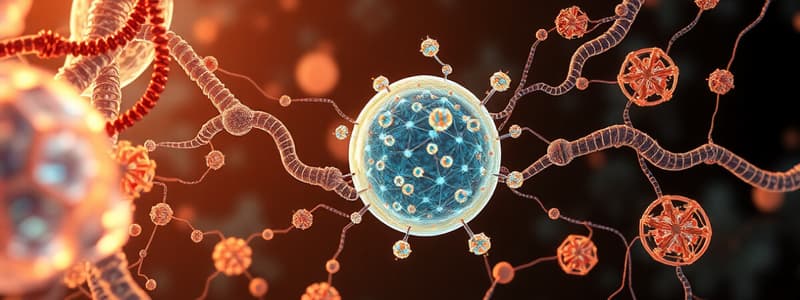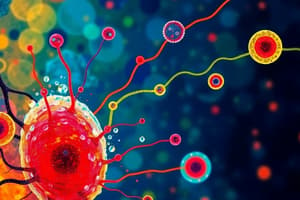Podcast
Questions and Answers
What is the primary function of internal receptors?
What is the primary function of internal receptors?
- They convert extracellular signals into intracellular signals.
- They regulate gene expression by binding to DNA. (correct)
- They facilitate the entry of hydrophilic ligands into the cell.
- They activate ion channels in response to ligand binding.
Which type of cell-surface receptor opens a channel for specific ions when activated?
Which type of cell-surface receptor opens a channel for specific ions when activated?
- G-Protein-Linked Receptors
- Transcription Factors
- Enzyme-Linked Receptors
- Ion Channel-Linked Receptors (correct)
What role do G-proteins play in cell-surface receptors?
What role do G-proteins play in cell-surface receptors?
- They act as transcription factors.
- They convert ligands into phosphates.
- They interact with other membrane proteins to propagate signals. (correct)
- They bind directly to DNA.
What occurs during phosphorylation in intracellular signaling?
What occurs during phosphorylation in intracellular signaling?
What are second messengers in intracellular signaling?
What are second messengers in intracellular signaling?
What is a function of cyclic guanosine monophosphate (cGMP)?
What is a function of cyclic guanosine monophosphate (cGMP)?
Which of the following is an example of a lipid messenger?
Which of the following is an example of a lipid messenger?
Which ion is mentioned as a second messenger that signals within and between cellular compartments?
Which ion is mentioned as a second messenger that signals within and between cellular compartments?
What is one role of gases like nitric oxide (NO) in cellular signaling?
What is one role of gases like nitric oxide (NO) in cellular signaling?
What is the structural composition of cyclic guanosine monophosphate (cGMP)?
What is the structural composition of cyclic guanosine monophosphate (cGMP)?
What is cell signal transduction primarily responsible for?
What is cell signal transduction primarily responsible for?
Which type of signaling involves communication between cells?
Which type of signaling involves communication between cells?
What role do ligands play in cell signaling?
What role do ligands play in cell signaling?
In intercellular signaling, what occurs during the formation step?
In intercellular signaling, what occurs during the formation step?
What is the first step in the process of cell signaling?
What is the first step in the process of cell signaling?
How do receptors contribute to cell signaling?
How do receptors contribute to cell signaling?
What type of signaling involves signals acting locally between nearby cells?
What type of signaling involves signals acting locally between nearby cells?
Which of the following is an example of a second messenger in cell signaling?
Which of the following is an example of a second messenger in cell signaling?
What is a characteristic of endocrine signaling?
What is a characteristic of endocrine signaling?
What is a key feature of a specific ligand in relation to cell receptors?
What is a key feature of a specific ligand in relation to cell receptors?
What is the primary outcome of signal processing in a target cell?
What is the primary outcome of signal processing in a target cell?
Which type of signaling is responsible for a cell responding to its own signaling molecules?
Which type of signaling is responsible for a cell responding to its own signaling molecules?
What is the main function of protein kinases in cell signaling?
What is the main function of protein kinases in cell signaling?
What limits the types of molecules that can pass through gap junctions in animals?
What limits the types of molecules that can pass through gap junctions in animals?
Which of the following takes the longest time to elicit a response in target cells?
Which of the following takes the longest time to elicit a response in target cells?
What is the role of gap junctions in cell communication?
What is the role of gap junctions in cell communication?
Flashcards are hidden until you start studying
Study Notes
Cell Signal Transduction
- The process by which cells respond to external chemical signals, crucial for communication and regulation of many biological processes.
- Two primary types:
- Intercellular signalling: communication between individual cells.
- Intracellular signalling: communication within a cell in response to either external or internal stimuli.
Intercellular Signalling
- Coordinates essential functions, ensuring the maintenance and proper function of specialized tissues and organs.
- Examples:
- Cell growth
- Cell division
- Cell motility
- Cell morphology
Signalling Receptors
- Receptors: protein molecules located either on the surface or within the cell. They bind to ligands, triggering a cellular response.
- Ligands: molecules that attach to specific receptors on a cell, conveying a message or signal.
- Ligands act like "keys" binding to "locks" (receptors) on the cell.
- A specific ligand typically has a specific receptor.
- Receptors are vital for cell communication and response.
Intercellular signalling: Steps
- Formation: An external trigger causes the production or release of signalling molecules (e.g., hormones) from specialized cells.
- Signal Transport: The signal travels to the target cell, often via circulation or diffusion, sometimes with carrier proteins.
- Signal Reception: The target cell receives the signal through specific receptors, initiating intracellular signaling pathways.
- Signal Processing: The signal is converted into a biochemical response within the target cell, leading to specific cellular actions.
Stages of Cellular Signal Transduction
- Reception: cells detect chemical signals through receptors.
- Transduction: the signal is converted into an internal response. Typically involves a series of steps with relay molecules.
- Response: the cell performs a specific action in response to the signal.
Reception:
- Ligand binds to receptor.
- Receptor changes shape, activating the cell.
Transduction:
- Often involves a series of steps with relay molecules.
- Protein Kinases: add phosphate groups to proteins, amplifying the signal.
Response:
- Action: could include changes in gene expression, enzyme activity, or cell metabolism.
- Examples: cell division, muscle contraction, or apoptosis (programmed cell death).
Forms of Chemical Cell Signalling
- Cells communicate through extracellular signalling molecules that bind to receptors on target cells, triggering a response.
- Depending on the distance the signal travels, there are four main forms of cell signalling:
Paracrine Signalling
- Signals act locally between nearby cells.
- Signals move by diffusion through the extracellular matrix.
- Elicit quick, short-lasting responses.
Endocrine Signalling
- Signals originate from distant endocrine cells.
- Located in endocrine glands like the thyroid, hypothalamus, and pituitary.
- Produce slower, longer-lasting effects.
- Hormones are released by glands into the bloodstream, where they travel long distances to target cells in different parts of the body.
Autocrine Signalling
- Signals produced and responded to by the same cell or similar cells.
- Signaling cell releases a signal that binds to its own receptors.
- Ensures proper tissue formation and function during early development.
Direct Signaling Across Gap Junctions
- Direct communication between neighbouring cells through water-filled channels.
- Gap junctions in animals, plasmodesmata in plants.
- Small molecules like calcium ions (Ca2+) can pass through; larger molecules cannot.
Types of Receptors
Internal Receptors
- Found in the cytoplasm or nucleus.
- Respond to hydrophobic ligands that cross the plasma membrane.
- Regulate gene expression by binding to DNA after a ligand-induced conformational change.
Cell-Surface Receptors
- Also known as transmembrane receptors.
- Bind external ligands without the ligands entering the cell.
- Specific to cell types and convert extracellular signals into intracellular actions.
Types of Cell-Surface Receptors
Ion Channel-Linked Receptors
- Open a channel through the membrane when a ligand binds, allowing specific ions to pass through and alter the cell's activity.
- Example: acetylcholine (nicotine receptor).
G-Protein-Linked Receptors
- Activate G-proteins upon ligand binding, which then interact with other membrane proteins to propagate the signal.
- G-proteins switch between active and inactive states to regulate cellular responses.
- Example: Dopamine.
Enzyme-Linked Receptors
- Have an intracellular domain that acts as an enzyme or associates with an enzyme.
- Ligand binding activates the enzyme, triggering a cascade of cellular events.
- Example: insulin receptor.
Examples of Common Events in Intracellular Signalling
- Phosphorylation: Adding a phosphate group to a protein by an enzyme called kinase, which can activate or deactivate the protein.
- Second Messengers: Intracellular, diffusible small molecules and ions that are quickly synthesized or released in response to signals from receptors, altering the activity of target signalling proteins.
Second Messengers (examples)
- Cyclic nucleotides:
- Cyclic adenosine monophosphate (cAMP)
- Cyclic guanosine monophosphate (cGMP)
- Lipid messengers:
- Originate within cell membranes.
- Inositol trisphosphate (IP3)
- Gases: can signal throughout the cell and even to neighbouring cells.
- NO
- CO
- Hydrogen sulphide (H2S)
- Ions: signal within and between cellular compartments.
- Calcium (Ca)
- Na and K
cGMP (Cyclic guanosine monophosphate)
- Structure: Nucleotide with a sugar, guanine base, and a single phosphate group in a cyclic bond.
- Function: Acts as a second messenger in processes like:
- Smooth muscle contraction
- Phototransduction in the eye
- Blood vessel dilation.
Studying That Suits You
Use AI to generate personalized quizzes and flashcards to suit your learning preferences.



